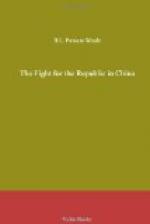What was this Central Government? In order successfully to understand an unparalleled situation we must indicate its nature.
The manoeuvres to which Yuan Shih-kai had so astutely lent himself from the outbreak of the Revolution had left him at its official close supreme in name. Not only had he secured an Imperial Commission from the abdicating Dynasty to organize a popular Government in obedience to the national wish, but having brought to Peking the Delegates of the Nanking Revolutionary Body he had received from them the formal offer of the Presidency.
These arrangements had, of course, been secretly agreed to en bloc before the fighting had been stopped and the abdication proclaimed, and were part and parcel of the elaborate scenery which officialdom always employs in Asia even when it is dealing with matters within the purview of the masses. They had been made possible by the so-called “Article of Favourable Treatment” drawn-up by Yuan Shih-kai himself, after consultation with the rebellious South. In these Capitulations it had been clearly stipulated that the Manchu Imperial Family should receive in perpetuity a Civil List of $4,000,000 Mexican a year, retaining all their titles as a return for the surrender of their political power, the bitter pill being gilded in such fashion as to hide its real meaning, which alone was a grave political error.
In spite of this agreement, however, great mutual suspicion existed between North and South China. Yuan Shih-kai himself was unable to forget that the bold attempt to assassinate him in the Peking streets on the 17th January, when he was actually engaged in negotiating these very terms of the Abdication, had been apparently inspired from Nanking; whilst the Southern leaders were daily reminded by the vernacular press that the man who held the balance of power had always played the part of traitor in the past and would certainly do the same again in the near future.
When the Delegates came to Peking in February, by far the most important matter which was still in dispute was the question of the oath of office which Yuan Shih-kai was called upon to take to insure that he would be faithful to the Republic. The Delegates had been charged specifically to demand on behalf of the seceding provinces that Yuan Shih-kai should proceed with them to Nanking to take that oath, a course of action which would have been held tantamount by the nation to surrender on his part to those who had been unable to vanquish him in the field. It must also not be forgotten that from the very beginning a sharp and dangerous cleavage of opinion existed as to the manner in which the powers of the new government had been derived. South and Central China claimed, and claimed rightly, that the Nanking Provincial Constitution was the Instrument on which the Republic was based: Yuan Shih-kai declared that the Abdication Edicts, and not the Nanking Instrument had established the Republic, and that therefore it lay within his competence to organize the new government in the way which he considered most fit.




